
Aktion T4 was a campaign of mass murder by involuntary euthanasia in Nazi Germany. The term was first used in post-war trials against doctors who had been involved in the killings. The name T4 is an abbreviation of Tiergartenstraße 4, a street address of the Chancellery department set up in early 1940, in the Berlin borough of Tiergarten, which recruited and paid personnel associated with Aktion T4. Certain German physicians were authorised to select patients "deemed incurably sick, after most critical medical examination" and then administer to them a "mercy death". In October 1939, Adolf Hitler signed a "euthanasia note", backdated to 1 September 1939, which authorised his physician Karl Brandt and Reichsleiter Philipp Bouhler to begin the killing.

Rosenheim is a city in Bavaria, Germany. It is an independent city located in the centre of the district of Rosenheim, and is also the seat of its administration. It is located on the west bank of the Inn at the confluence of the rivers Inn and Mangfall, in the Bavarian Alpine Foreland. It is the third largest city in Upper Bavaria with over 64,000 inhabitants. Rosenheim is the economic centre and the busiest place in the region.
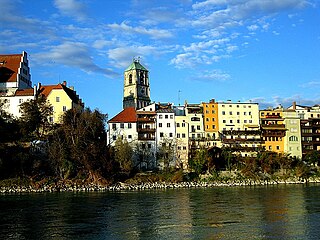
Wasserburg am Inn is a town in Rosenheim district in Upper Bavaria, Germany. The historic centre is a peninsula formed by the meandering river Inn. Many Medieval structures remain intact, giving the city a unique view.
Hans Heinze, sometimes referred to as Euthanasie-Heinze, was a Nazi German psychiatrist and eugenicist.

The Bethel Foundation, officially the Bodelschwingh Foundation Bethel is a diaconal psychiatric hospital in Bethel, formerly a town, today a neighbourhood of Bielefeld, Germany.

Kirche am Steinhof, also called the Church of St. Leopold, is the Roman Catholic oratory of the Otto-Wagner-Spital in the area of Steinhof in Vienna, Austria. The building, designed by Otto Wagner, is considered one of the most important Art Nouveau churches in the world.

Föhrenwald was one of the largest displaced persons camps in post-World War II Europe and the last to close, in 1957. It was located in the section now known as Waldram in Wolfratshausen in Bavaria, Germany.
Sh'erit ha-Pletah (Hebrew: שארית הפליטה, romanized: Sh'erit ha-Pletah, meaning surviving remnant, and is a term from the Book of Ezra and 1 Chronicles is a Hebrew term for the more than 250,000 Jewish Holocaust survivors living in Displaced Persons camps after the end of the Holocaust and Second World War, and the organisations they created to act on their behalf with the Allied authorities. These were active between 27 May 1945 and 1950–51, when the last DP camps closed.
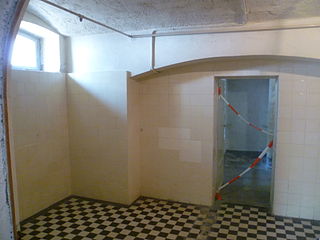
The Hadamar killing centre was a killing facility involved in the Nazi involuntary euthanasia programme known as Aktion T4. It was housed within a psychiatric hospital located in the German town of Hadamar, near Limburg in Hessen.
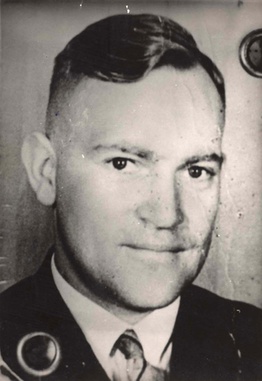
Horst Schumann was an SS-Sturmbannführer (major) and medical doctor who conducted sterilization and castration experiments at Auschwitz and was particularly interested in the mass sterilization of Jews by means of X-rays.
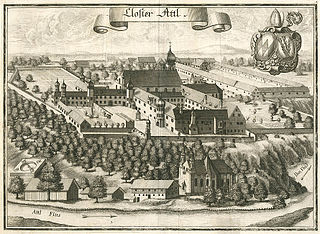
Attel Abbey, also Attl Abbey, was a Benedictine monastery, later a home for the disabled run by the Brothers Hospitallers, in the village of Attel near Wasserburg am Inn in Bavaria, Germany.
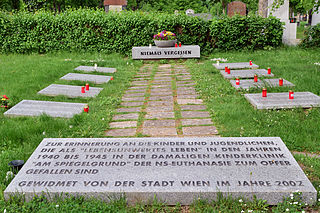
Am Spiegelgrund was a children's clinic in Vienna during World War II, where 789 patients were murdered under child euthanasia in Nazi Germany. Between 1940 and 1945, the clinic operated as part of the psychiatric hospital Am Steinhof later known as the Otto Wagner Clinic within the Baumgartner Medical Center located in Penzing, the 14th district of Vienna.

Werneck is a market town in the district of Schweinfurt in Lower Franconia, Bavaria, Germany. It has a population of around 10,000 and is best known for its Baroque palace, Schloss Werneck.
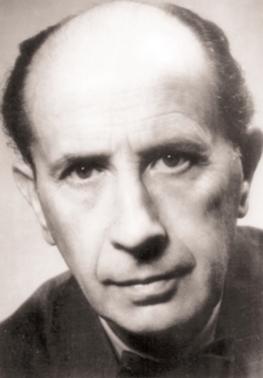
Karl Kleist was a German neurologist and psychiatrist who made notable advances in descriptive psychopathology and neuropsychology. Kleist coined the terms unipolar (‘einpolig’) and bipolar (‘zweipolig’) that are now used in the concepts of unipolar depression and bipolar disorder. His main publications were in the field of neurology, and he is particularly known for his work on the localisation of function in the cerebral cortex of man including mapping of cortical functions on brain maps. The work is based on several hundred cases of shot wounded patients of World War I, whose functional deficits Kleist deliberately studied and described in detail during their lifetime. Later on, by means of brain autopsy, he documented the lesion and was, thus, able to localize brain function in each single case doing this also on cytoarchitectonical grounds. Kleist was a student of Carl Wernicke and his work was closely associated with the Wernicke tradition. Among his students were Edda Neele and Karl Leonhard, who further developed the Kleist-Leonhard classification system of psychosis.

Paul Gösch, also Goesch or Göschen, was a German artist, architect, lithographer, and designer of the early twentieth century; he was associated with the main elements of German Expressionism.

The Sonnenstein Euthanasia Clinic was a Nazi killing centre located in the former fortress of Sonnenstein Castle near Pirna in eastern Germany, where a hospital had been established in 1811.

The Nazi Euthanasia Centre at Bernburg operated from 21 November 1940 to 30 July 1943 in a separate wing of the State Sanatorium and Mental Hospital in Bernburg on the River Saale in the German state of Saxony-Anhalt. It was one of several euthanasia centres run by the Nazis under their official "Euthanasia Programme", later referred to after the war as Action T4. A total of 9,384 sick and handicapped people from 33 welfare institutions and nursing homes as well as around 5,000 prisoners from six concentration camps were killed there in a gas chamber using carbon monoxide gas.

The Provincial Mental Sanatorium Kortau was a psychiatric hospital in Kortau, East Prussia. Founded in 1886, it was located about 2 km south of the town center of Allenstein (Olsztyn), at the Kortsee. The hospital housed up to 1,400 patients from all over East Prussia. During World War II, many of Kortau's patients were sent to Germany and executed as part of Nazi Germany's euthanasia programme. Most of the remaining patients and staff were killed by the Red Army in January 1945.
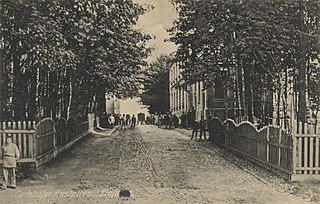
The Carlshof Institutions was a diaconal hospital in Carlshof, East Prussia. Founded in 1882, it was located about 3 km (1.9 mi) east of the town center of Rastenburg (Kętrzyn). Carlshof housed up to 1,500 inmates from all over East Prussia and specialized in treating patients with epilepsy and intellectual disability; it also cared for alcoholics, elderly, and juveniles as well as homeless persons. In World War II, Carlshof served as a military hospital and barracks for Hitler's nearby headquarters at the Wolf's Lair.
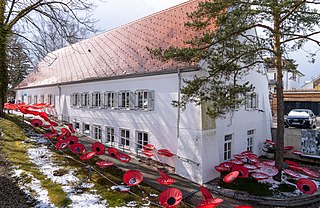
The Erinnerungsort Badehaus is a historical museum situated at Kolpingplatz in Waldram, a district of the town of Wolfratshausen, approx. 30 km south of Munich (Germany). Documents of the settlement's history since its foundation in 1939 are exhibited in the museum. It is an extracurricular place of learning and a place of encounters for various generations, nations and religions. The association Bürger fürs Badehaus Waldram-Föhrenwald e.V. is owner and operator of the museum. It saved the building from demolition, had it refurbished and developed the concept for it to be turned into a museum. All the activities of people are and have been on an honorary basis. In 2022 the museum received the Obermayer-Award for its outstanding engagement in saving the Jewish history and for its ongoing fight against current prejudices.




















